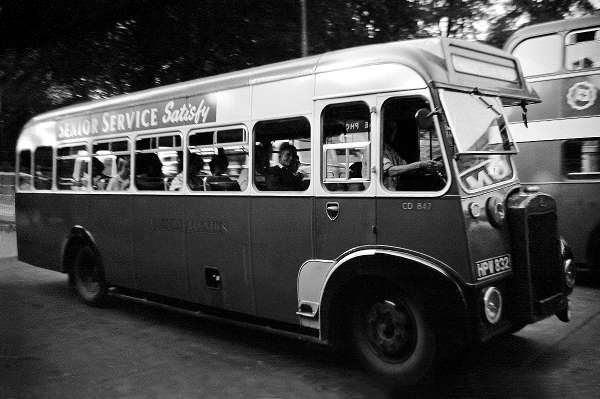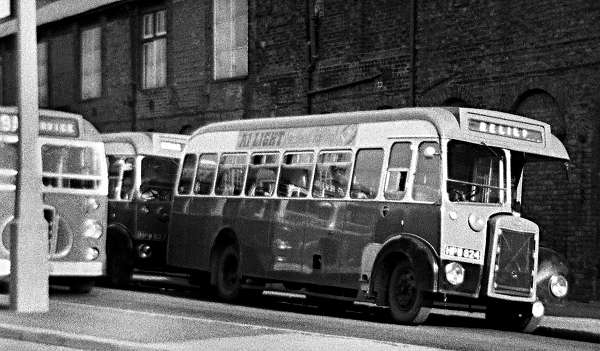Eastern Counties Dennis/ECW Integral Buses
Eastern Counties Dennis/ECW Integral Buses
In 1938 and 1939, Eastern Counties took delivery of 18 Dennis Aces with ECW B20F bodies and Gardner 4LK engines. Two more unfrozen examples arrived in 1941. In 1947, at a time of acute vehicle shortages, a prototype Beadle chassisless bus appeared in the Eastern Counties fleet. It was one of four Beadle prototypes being evaluated by the Tilling group using mechanical components from older, withdrawn vehicles. Fleet no. D999, FNG 818, had a full fronted 33 seat rear entrance body fitted with running units and Gardner 4LK engine taken from United Counties Dennis Ace No.504, VV 7278. It was finally withdrawn in 1959. A batch of 16 similar vehicles, but with Bedford units and petrol engines, followed in 1949. The petrol engines were later replaced by 4LK diesels. Encouraged by the success of these lightweights, ECOC salvaged components and the 4LK engines from the withdrawn Dennis Aces. These units were then incorporated into 16 new half cab B32R chassisless machines by Eastern Coach Works, and registered HPW 817-832, fleet numbers CD 832-847. They were delivered in 1950. This vehicle type, bearing the legend 'ECW' as the manufacturer on its distinctive radiator, was unique to Eastern Counties. These little buses mostly spent their eleven year lives running very reliably on the flatter fenland territory in the western part of the ECOC area, and, on withdrawal in 1961, they then donated their 4LK engines to the Bristol SC4LK overhaul stock.
Roger Cox
05/14

HPW 832, fleet no.CD 847, was the last of the class. It is shown leaving Cambridge Drummer Street Bus Station destined for Newmarket in August 1959. Rather remarkably, the blind is correctly set. The narrow track of the front and rear axles may be clearly seen.

Seen parked in Kings Lynn in August 1960 bearing the informative destination 'Relief', HPW 824, fleet no.CD 839 stands in front of HPW 827, CD842, which commendably displays 'Kings Lynn'. On the left, one of the many SC4LKs in the ECOC fleet shows the depressingly familiar 'Service' in the route indicator box.
02/05/14 - 17:57
I have vague memories of these from my infrequent visits to the area with my father in the late 1950s. I recall it took me some time to find out what they were.
The radiators let down what would have been an otherwise good looking bus, were these modified from then original Dennis design? Also what is the round object to add the top of the dash panel?
Thanks Roger for dragging out something from deep in the recesses of the memory.
Phil Blinkhorn
03/05/14 - 17:30
Phil, I'm pretty sure that Dennis never made a radiator shell of anything like that shape. I've got nothing against the appearance of it: I find it honest and businesslike. What I think spoils the appearance is the narrow front track. Were the bodies 8' wide?
Ian T
04/05/14 - 07:36
I know what you mean about those radiators. They always remind me of one of those cheap, plastic toy buses - probably with a friction-drive push along motor - that when you were a child your cheapskate auntie would buy you for Christmas from a market stall, as opposed to the quality Dinky or Corgi ones from your parents ! They were otherwise quite neat little buses, and a sort of precursor to the Bristol SC, maybe. A shame one did not survive.
John Stringer
04/05/14 - 07:37
Ian, these buses were definitely only 7ft 6ins wide. The narrow track of both the front and rear axles was inherited from the Ace design. The effect at the front of the Ace was less obvious because the body/bonnet layout tapered towards the radiator, and the front wings were set inboard of the main body width; see this link
On the ECW chassisless machines the parallel sided, forward control character of the bodywork accentuated the narrowness of the track. The radiator design certainly owed nothing to Dennis. In response to Phil's query, I, too, have been baffled by the purpose of the circular object on the outside of the dash panel. This component appears to be situated directly in line with the steering column inside the cab, and I wonder if it has some structural support function, bearing in mind that these buses were of lightweight chassisless construction. www.sct61.org.uk/
Roger Cox
05/05/14 - 07:37
Could that bump on the front be a ventilator? Clearly, though, the windscreen opens. If the bus were going backwards, it would be an extractor!
Joe
06/05/14 - 07:46
I remember being told by a former Coachworks employee that these cute little buses were built as an experiment in integral construction techniques prior to the LS production a few years later and to produce higher capacity more modern vehicles than the original Aces. I've always thought the disc on the dash panel was a ventilator; I seem to remember ECW using similar ventilators on other vehicles. I only once came across one of them on a quiet Sunday morning parked up on Angel Hill, Bury St Edmunds when there was no other sign of life in the town that day!
Ray Stringer
Comments regarding the above are more than welcome please get in touch via the 'Contact Page' or by email at
If you have a bus related article that you would like to appear on this site please get in touch via the 'Contact Page' or by email at
All rights to the design and layout of this website are reserved Old Bus Photos does not set or use Cookies but Google Analytics will set four see this
Old Bus Photos from Saturday 25th April 2009 to Saturday 27th April 2024